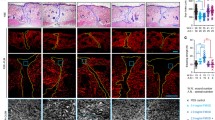Abstract
Fibroblasts in healing wounds are activated by cytokines secreted by cells at the wound site, especially macrophages and T-lymphocytes-paracrine mechanism. Biochemical control of fibroblast activity is most likely to be activated by inhibiting these cells or by neutralizing their cytokines. TGFβ is the most likely target.
Similar content being viewed by others
References
Arturson G (1996) Pathophysiology of the burn wound and pharmacological treatment. Burns 22:235–274
Devel TF, Huang JS (1984) Platelet-derived factor: Structure, function and roles in normal and transformed cells. J Clin Invest 74:669–676
Assoian RK, Komoriya A, Meyers CA, Miller DM, Sporn MB (1988) Transforming growth factor - beta in human platelets: Identification of a major storage site purification and characterisation. J Biol Chem 258:7155–7160
Baird A, Mormede P, Bohlen P (1985) Immunoreactive fibroblast growth factor in cells of peritoneal exudate suggests its identity with macrophage-derived growth factor. Biochem Biophys Res Commun 126:358–364
Blotnik S, Peoples GE, Freeman MR, Eberlein TJ, Klagsbrun M (1994) T lymphocytes synthesise and export heparin-binding epidermal growth factor-like growth, factor and basic fibroblast growth, factor mitogens for vascular cells and fibroblasts. Differential production and release by CD4+ and CD8+ cells. Proc Natl Acad Sci USA 91:2890–2894
Leibovich SJ, Ross R (1975) The role of the macrophage in wound repair: A study with hydrocortisone and antimacrophage serum. Am J Pathol 78:71–100
Barnmill RL, Doll NJ, Millikan LE, Hastings RC (1984) Studies on the anti-inflammatory properties of thalidomide: Effects on polymorpho-nuclear leukocytes and monocytes. J Am Acad Dermatol 11:814
Keenan RJ, Eiras G, Burckart GJ, Stuart RS, Hardesty RL, Vogelsang G, Griffith BP, Zeevi A (1991) Inhibition of in vitro lymphocyte proliferation by thalidomide alone and in combination with cyclosporin or FK 506. Transplantation 52:908–910
Barbul A (1988) Role of the T cell dependent immune system in wound healing. In growth factors and other aspects of wound healing. Biological and clinical applications. Alan R Liss, New York
Martin CW, Muir IFK (1990) The role of lymphocytes in wound healing. Br J Plast Surg 43:655–662
Muir IFK, Barclay TL, Settle JAD (1987) Burns and their treatment, 3rd edn. Butterworth, London
Holmes JD, Muir IFK, Rayner CR (1983) A hypothesis of the healing of deep partial thickness burns and the significance for treatment. Br J Surg 70:611–613
Eisinger M, Sadans S, Silver IA, Flick RB (1988) Growth regulation of skin cells by epidermal cell-derived factors: Implication for wound healing. Proc Natl Acad Sci USA 85:1937–1941
Page RF, Barclay TL (1980) Correlation of scald depth and hypertrophic scar formation. Burns 7:173
Holmes JD, Rayner CRW, Muir IFK (1987) The treatment of deep dermal burns by abrasion. Scand J Plast Reconstr Surg 21:237
Gillman T, Penn J, Bronks D, Roux M (1955) A re-examination of certain aspects of the healing of cutaneous wounds. Br J Surg 70:611–613
Muir IFK, Padilla-Lamb A, Stewart J, Wheatley DN (1996) Inhibition of fibroblasts by extracts of human dermis. Br J Plast Surg (in press)
El Sheemy M (1997) PhD thesis University of Aberdeen
Adzick NS, Harrison MR, Glick PL, Beckstead JH, Villa RL, Schevenstuhl M, Goodson WH (1985) Comparison of foetal, newborn and adult wound healing by histological, enzyme-histochemical and hydroxyproline determination. J Paediatr Surg 20:315–319
Ferguson MJW (1994) Skin wound healing. Transforming growth factor B antagonists decrease scarring and improve quality. J Interferon Res 14:303–304
Shah M, Foreman DM, Ferguson MWJ (1992) Control of scarring in adult wounds by neutralising antibody to TGFB. Lancet 339:213–214
Shah M, Foreman DM, Ferguson MWJ (1995) Neutralisation of TGBF1 and TGFB2 or exogenous addition of TGFB3 to cutaneous rat wounds reduces scarring. J Cell Sci 108:15–17
Jamaguchi Y, Mann D, Ruoslahti E (1990) Negative regulation of transforming growth factor B by the proteoglycan decorin. Nature 346:281–284
Author information
Authors and Affiliations
Rights and permissions
About this article
Cite this article
Muir, I.F.K. Control of fibroblast activity in scars: a review. Eur J Plast Surg 21, 1–7 (1998). https://doi.org/10.1007/BF01152415
Received:
Accepted:
Issue Date:
DOI: https://doi.org/10.1007/BF01152415




